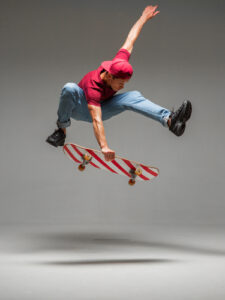 Leonardo da Vinci identified a “second form of the human body,” the one created by the limbs as they move through the space around the body. Laban named these secondary forms “trace-forms.”
Leonardo da Vinci identified a “second form of the human body,” the one created by the limbs as they move through the space around the body. Laban named these secondary forms “trace-forms.”
These movement forms are limited both by the mover’s body and by the nature of the space we inhabit.
Bodily limits include joint structure, proportional relations among body parts, and range of motion. These limitations govern where our limbs can move in the surrounding space.
In addition, we inhabit a gravitation field in a three-dimensional terrestrial space. This means that certain spatial trajectories are stable due to their relation to the plumb line of gravity. Other trajectories are mobilizing and can be maintained only briefly before requiring a foothold or counter-tension, or a jump or fall will result.
By respecting these limits, Laban was able to create Choreutic patterns that serve as a design source for movement and dance.
